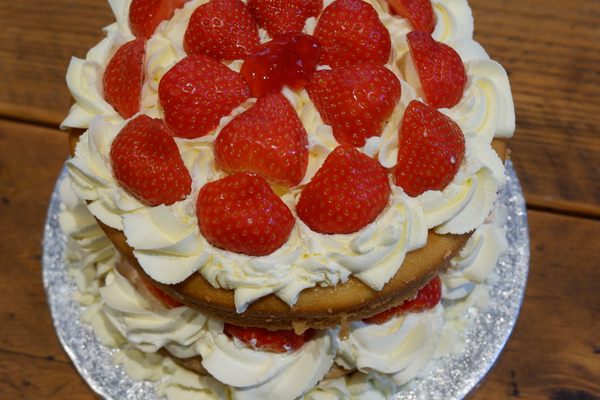In a city known for sweets, there is little that makes local mouths water more than the towering, historic doberge cake.
“It has to be at least six layers,” insists Charlotte McGehee, co-owner of Bakery Bar and Debbie on the Levee, two bakeries in New Orleans, Louisiana, that specialize in doberge (DOH-bash) cake. “In my opinion, fewer than six is just a regular ol’ layer cake. You miss out on that feeling of your fork working through each alternating texture, and the nervousness you get because you don’t want that beautiful tower of cake to topple before you make it to the bottom.”
The dessert’s decadent journey begins with a thin layer of yellow butter cake as the base, topped with an equally thin layer of custard—traditionally chocolate-, lemon-, or caramel-flavored. A baker then repeats that process as many times as they see fit—some cakes boast a whopping 15 layers and, as McGehee noted, it’s strange to see fewer than six. (For perspective, the recipe in the cake originator’s own cookbook has eight layers.)
The baker then covers their tower with buttercream icing, finishes it with fondant, and—voilà!—they have created a traditional New Orleans doberge cake.
“Everyone knows king cake around Mardi Gras, but doberge is something many local families celebrate with year-round,” explains Vincent Scelfo, owner of Gambino’s Bakery, which has made doberge near New Orleans for 75 years and is one of the treat’s most popular purveyors.
“We have 70-year-old customers who say they’ve had a Gambino’s doberge cake at every single one of their birthdays,” Scelfo says. “Their grandparents bought them one when they were a kid and now they’re buying one for their grandkids’ birthdays, too.”
Doberge cake is a descendant of the Austro-Hungarian dobos (pronounced DOH-bosh) torte, an elegant, layered pastry invented in late-19th century Budapest. Hungarian chef József C. Dobos created the dobos torte to outlast other cakes during an age with limited cooling techniques. Its many layers of then-rare buttercream filling, and its hardened caramel top helped prevent Dobos’ Italian-style sponge cake from drying and allowed it to be shipped.
The woman credited with turning the dobos torte into the doberge cake is a New Orleanian baker named Beulah Ledner. Born in the nearby town of St. Rose in 1894, Ledner came from a family of European-Jewish immigrants that included a grandfather who was a respected baker in Germany. During the early years of the Great Depression, Ledner supplemented her family’s income by opening a home bakery called Mrs. Charles Ledner’s Superior Home Baking. Her lemon pies were a hit, but it was her version of the dobos torte, a popular dessert among American Jews of the early 1900s, that would leave a lasting mark on New Orleans cuisine.
Ledner adapted the cake to a city that was much hotter and more humid than Budapest. She felt local palates would prefer a lighter dessert, so she not only introduced yellow butter cake in place of the dobos torte’s sponge, but she also substituted a lighter custard filling for the original’s heavier buttercream.
Finally, to fit the French heritage of the new cake’s home, Ledner gave the dessert a francophile touch, switching its name from dobos to doberge.
Her intuition proved correct. She earned the title “Doberge Queen of New Orleans” as she made doberge cake for the city’s residents for decades. Her business’s success prompted her to turn her operation into a brick-and-mortar that moved several times before closing in 1946 when Ledner suffered a heart attack. Soon after, she opened a second, Beulah Ledner, Inc, where she churned out doberge cake until she was 87. Now, approaching a century since its creation, doberge in the style of Beulah Ledner is still available and popular in southeast Louisiana.
“The recipe is almost exactly what Beulah created so long ago,” says Scelfo, whose Gambino’s Bakery purchased Mrs. Charles Ledner’s Superior Home Baking, along with her recipes, in 1946.
“It’s a light, refreshing filling alternated with a rich cake,” he adds. “Perfect for New Orleans, just like Beulah Ledner wanted it to be.”
You can make one yourself using this recipe from “Let’s Bake” with Beulah Ledner: A Legendary New Orleans Lady, by Ledner’s daughter, Maxine Wolchansky.
Where to Try It
-
Located 10 minutes outside New Orleans, Gambino’s purchased the doberge cake recipe from Beulah Ledner in 1946. Try the cake in its original flavors, such as chocolate, lemon, and caramel, or choose the local favorite: a doberge cake that is chocolate on one half and lemon on the other. If you can’t make the trip to New Orleans, Gambino’s also offers nationwide shipping.
-
Maurice French Pastries Website
3501 Hessmer Ave, Metairie, Louisiana, 70002, United StatesUpon retiring, Ledner sold Beulah Ledner, Inc and her recipes to a bakery that would eventually become Maurice French Pastries. In addition to a plethora of French sweets, Maurice still sells doberge cakes in a variety of traditional flavors, as well as with a few creative twists. One version combines another local favorite, pralines, to the cake.


















